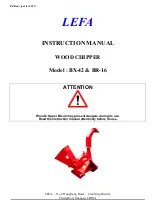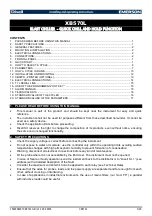
CTV-PRB004-EN
77
Glossary
functions are displayed as standard on the unit controller.
See the comparison tables (
Table 2, p. 13
and
Table 3,
p. 14
).
Isolation switch
A device used to connect and disconnect a load to and
from line power for servicing. Isolation switches are non-
load break and cannot be opened under load. Trane
®
medium-voltage starters have a mechanical interlock that
prevents the isolation switch from being opened while the
chiller is running. This is a standard item on Trane
®
medium-voltage starters.
K
Kirk key
A locking arrangement between a remote disconnect
switch and a starter that is designed to prevent closing the
remote switch and powering the starter that is being
serviced.
A single key is used and it is held captive in the disconnect
switch. The disconnect switch must be opened and then
locked open. The kirk key may then be removed and used
to unlock the starter. The key remains captive in the
starter until the starter door is closed and locked. The key
may then be removed and used to unlock the disconnect
switch. The switch may then be closed.
L
Lightning arrester
A device that protects electrical equipment from high
voltage spikes by providing a high resistance path (an air
gap) to ground—essentially an air gap small enough to
allow a spark-over to occur for voltages much larger than
the chiller’s operating voltage. The device provides
protection by consistently conducting to ground when the
magnitude of the voltage exceeds a predetermined value.
Although lightning arresters may be used alone, they are
used usually in conjunction with surge protection
capacitors.
The function of a lightning arrester is to limit the
magnitude of a voltage spike. The function of a surge
capacitor is to limit the rate of rise of a voltage spike. See
“Surge capacitor,”
p. 80
.
Lightning arresters are a starter option.
Load-break switch (LBS)
A manual switch that has an interrupting rating and can be
used to safely interrupt a live circuit. It is sometimes called
an ADM switch. This term is typically used with medium-
voltage starters when customers want Trane to provide a
load-break switch. The standard isolation switch that
comes with medium-voltage starters is non-load break.
The load-break switch is a design special. The switch is
housed within a 90" high, 36" wide, and 30" deep
enclosure. A circuit breaker or non-fused disconnect on
low-voltage starters can be used as a load-break switch.
Locked-rotor amps (LRA)
See “Amps, motor locked-rotor amps (LRA)”,
p. 73
.
Lug
A device used to mechanically connect a conductor (wire)
to a piece of electrical equipment. Lugs are furnished by
the starter vendor. The number of wires per phase and
range of wire sizes that the lugs will accept are listed in
the starter submittals. The range of wire sizes indicates
the maximum size wire that will fit into the lug hole and
the minimum wire size that the screw can securely clamp
in place. Optional lugs that accommodate different
number of wires per phase and size are generally available
for every starter. These can be purchased through a local
vendor if required.
Note:Wire sizes “pulled” by contractor that are different
from the lug sizes shown on the starter submittal
will impact the lug sizes needed. In this case, the
correct lug sizes must be obtained locally.
M
Maximum overcurrent protection (MOP)
The maximum overcurrent protection (MOP, or sometimes
abbreviated as MOCP) appears on the chiller nameplate.
The electrical engineer often wants to know the MOP
when selections are being made. It is used to assist in the
sizing of fuses and circuit breakers. MOP is an output of
the TOPSS selection program. Also see the discussion on
fuse and circuit breaker sizing (
“Electrical System—
Ratings,” p. 49
and
“Electrical System—Design
Guidelines,” p. 52
). Use of improperly sized circuit
breakers can result in nuisance trips during the starting of
the chiller. For CenTraVac chillers the MOP is NOT the
value used to size incoming wire (see MCA).
Minimum circuit ampacity (MCA)
This term appears on the chiller nameplate and is used by
electrical engineers to determine the size and number of
conductors bringing power to the starter. The formula for
MCA is 1.25 x (Primary RLA) + (4000/motor voltage),
rounded up to the next whole number. The formula is
125 percent of the motor design RLA plus 100 percent of
the amperage of other loads (control-power transformer,
CTV-PRB004.book Page 77 Sunday, December 18, 2011 6:39 PM






































